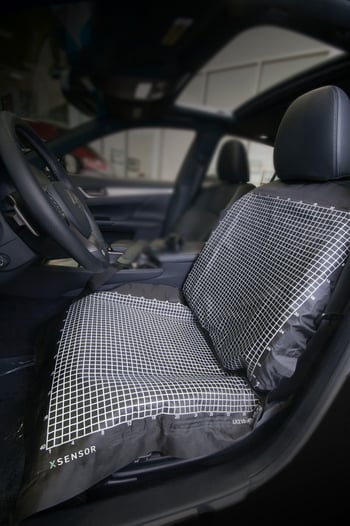
The Importance of Automotive Seat Testing
Learn more about how seat testing technology can help inform seating design.
Most consumers don't realize just how much thought is put into designing a vehicle's seats during vehicle development. In addition to ensuring that the seats are as comfortable as possible, it is also important to develop durable seats that will help keep passengers safe in the event of a crash. Given these varying standards that a good automotive seat design needs to meet, comprehensive testing is a vital element in designing a new seat.
In this article, we'll cover what seat testing entails, why it's important, and the benefits provided by XSENSOR's industry-leading seating and ergonomics testing solutions.
What is Automotive Seat Testing?
Several factors need to be considered when testing the design of a new seat. The first is how comfortable the seat is for its passengers. Engineers need to gather hard data on their seat's comfort and ergonomics. Using pressure sensors can help determine how the seat distributes its passenger's weight and pinpoint any areas of excess pressure that might cause discomfort. In addition to ensuring that a seat's design is comfortable for a passenger while sitting in it, it's also important for engineers to design a seat that is durable so that it doesn't break down as passengers enter and exit the vehicle. This consideration in a seat's design is known as its ingress and egress.
Once engineers have confirmed that their seat offers optimum comfort, the next step in seat testing is to ensure that the seat's materials and design are durable enough to last for the vehicle's lifetime. The process of entering and exiting a seat over and over again can create a lot of wear and tear. A robot shaped like a metallic buttox is often used to simulate the pass pattern of entering and exiting a seat thousands of times to test a seat's ability to stand up to this prolonged friction.
Along with testing the seat's resistance to the friction caused by ingress and egress, it's also important for engineers to test other areas of a seat's durability. Exposing the seat to extreme hot and cold temperatures helps engineers ensure that their seat's materials won't incur damage from extreme temperatures. Engineers will also conduct a fatigue test that simulates driving thousands of miles over an uneven surface to see how the seat handles the constant jostling and jarring.
Lastly, engineers need to design a seat with crash safety in mind. While a wide range of factors goes into determining how much protection a vehicle provides its passengers in the event of a crash, the design of its seats is undoubtedly one of those factors. The design of a seat's headrest can go a long way toward preventing head and neck injuries such as whiplash. A car's seats are also responsible for housing vital safety equipment such as seatbelts and side-impact airbags. To test how much crash safety a seat provides, engineers utilize a mechanical sled to simulate a number of vehicle impact scenarios.
Challenges in Automotive Seat Testing
As with any automotive testing - including tire testing, crash testing, and beyond - one of the biggest challenges of seat testing is gathering accurate and repeatable data. Using reliable data to make decisions, engineers need to employ the latest automotive seat testing technology.
The challenge for automotive engineers is to design a seat that features recyclable or eco-friendly materials while still offering the same level of comfort and durability that consumers have come to expect. There is an increase in demand to create eco-friendly vehicles, which includes the materials used inside. While the benefits of building an eco-friendly vehicle are apparent, these materials aren't always the best options in terms of durability and comfort.
 How XSENSOR's X3 Pro Seating System is Improving the Seat Testing Process
How XSENSOR's X3 Pro Seating System is Improving the Seat Testing Process
To provide automotive engineers with the ability to collect accurate and reliable data on their seat's design, at XSENSOR, we are proud to offer our innovative X3 Pro Seating System. This seat testing platform enables engineers to collect detailed interface pressure measurements on seat and back surfaces that can then be used to optimize the seat's comfort.
In addition to providing crucial data on how comfortable a seat will be for its passengers, the X3 Pro Seating System's state-of-the-art LX series seating and ergonomics sensors also provide engineers with data on the seat's durability, ingress, and egress, and when combined with XSENSOR’s HS DAQ can measure crash test safety. This all-in-one system gives engineers the ability to accurately test every aspect of the design of their seats, leading to seats that are safer, longer-lasting, and more comfortable while at the same time streamlining the seat testing process.
To learn more about our cutting-edge X3 Pro Seating System or any of the other automotive testing technologies that we offer at XSENSOR, feel free to contact us today.

